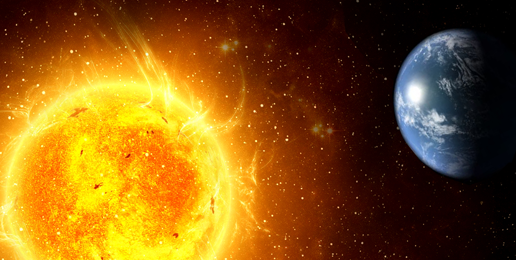
The sun and not human emissions of carbon dioxide (CO2) may be the main cause of warmer temperatures in recent decades, according to a new study with findings that sharply contradict the conclusions of the United Nations (UN) Intergovernmental Panel on Climate Change (IPCC).
The peer-reviewed paper, produced by a team of almost two dozen scientists from around the world, concluded that previous studies did not adequately consider the role of solar energy in explaining increased temperatures.
The new study was released just as the UN released its sixth “Assessment Report,” known as AR6, that once again argued in favor of the view that man-kind’s emissions of CO2 were to blame for global warming. The report said human responsibility was “unequivocal.”
But the new study casts serious doubt on the hypothesis.
Calling the blaming of CO2 by the IPCC “premature,” the climate scientists and solar physicists argued in the new paper that the UN IPCC’s conclusions blaming human emissions were based on “narrow and incomplete data about the Sun’s total irradiance.”
Indeed, the global climate body appears to display deliberate and systemic bias in what views, studies, and data are included in its influential reports, multiple authors told The Epoch Times in a series of phone and video interviews.
“Depending on which published data and studies you use, you can show that all of the warming is caused by the sun, but the IPCC uses a different data set to come up with the opposite conclusion,” lead study author Ronan Connolly, Ph.D. told The Epoch Times in a video interview.
“In their insistence on forcing a so-called scientific consensus, the IPCC seems to have decided to consider only those data sets and studies that support their chosen narrative,” he added.
The implications, from a policy perspective, are enormous, especially in this field where trillions of dollars are at stake and a dramatic re-organization of the global economy is being proposed.
Paper Examines Sun Vs. CO2
Using publicly available data sets from the U.S. government and other sources, it is easy to explain all of the warming observed in recent decades using nothing but changes in solar energy arriving on Earth, according to the new paper.
Indeed, while it agrees that using the data sets chosen by the UN would imply humans are largely to blame, the study includes multiples graphs showing that simply choosing different data sets not used by the UN upends the IPCC’s conclusion.
If confirmed, the study, published in the international scientific journal Research in Astronomy and Astrophysics (RAA) by experts from over a dozen countries, would represent a devastating blow to the UN IPCC and its conclusion that man’s emissions of CO2 are the sole or even primary driver of warming.
While the paper calls for further research to resolve differences between conflicting data sets and studies, the authors show conclusively that, depending on the data sets being used, it is entirely possible that most or even all of the warming has nothing to do with man.
Using 16 different estimates on the amount of solar energy, dubbed “Total Solar Irradiance,” the review compares that data with over 25 estimates of temperatures in the Northern hemisphere stretching back to the 1800s.
When solar data from NASA’s “ACRIM” sun-monitoring satellites are compared to reliable temperature data, for example, virtually all of the warming would be explained by the sun, with almost no role at all for human emissions.
And yet, for reasons that the study authors say are murky at best, the UN chooses to ignore the NASA ACRIM data and other data sets in favor of those that support the hypothesis of human responsibility for climate change.
The UN IPCC reports, including the recently released 6th Assessment Report, have consistently blamed human activities such as the emission of so-called “greenhouse gases” for the observed changes. Many studies in the scientific literature have agreed with the UN IPCC position.
However, the new study, titled “How much has the Sun influenced Northern Hemisphere temperature trends? An ongoing debate,” cites dozens of other studies that have pointed to the sun—not human activity—as the primary driver of climate changes.
According to the study authors, these dissenting scientific views have been deliberately suppressed by the IPCC and have not been reflected in the UN IPCC reports, for reasons that have not been adequately explained.
A spokesman for the IPCC denied wrongdoing by the UN body in comments to The Epoch Times and said the new study had been accepted for publication after the deadline for consideration.
The paper in RAA agrees that the planet has warmed somewhat since the late 19th century, when reliable data collection began in the northern hemisphere.
However, in another challenge to the UN’s influential report, even the temperature data sets used by the IPCC are subjected to criticism in the new paper and others.
Among other concerns, the study highlighted apparent flaws in the approach used by the IPCC for estimating global temperature changes using data from both urban and rural locations.
According to the study’s authors, including urban data sets results in an artificial upward skewing of temperatures due to the well-known “urban heat island” effect that must be taken into account.
Basically, cities tend to be warmer than the countryside due to human activity and structures, so temperature stations that had cities grow up around them will show artificial temperature increases caused by the urbanization rather than global warming.
The IPCC has rejected those concerns, arguing that urbanization only played a very minor role in the estimate temperature increase.
Why the Apparent Bias?
Asked why these views have been ignored and even suppressed, lead study author Connolly suggested “confirmation bias” was at work. This is when individuals only consider information that supports their bias, something Connolly said affects all scientists.
While this may be at work in the IPCC’s selection of data sets and studies to consider and include, it is hard to know for sure, he said, expressing concern that the UN IPCC was only considering data sets and studies that “support the chosen narrative.”
“Whether they were deliberately doing it or whether it was simply confirmation bias is difficult to say, but it is clear that data sets are being selected that support the IPCC view while data contradicting it have been excluded,” added Connolly, who has a doctorate in Computational Chemistry and is affiliated with the Center for Environmental Research and Earth Sciences (CERES).
Connolly also said that the IPCC ignored key recent papers contradicting its conclusions, even denying that any such new papers existed despite leading IPCC scientists having cited those same papers in their own work.
For instance, a related 2015 paper published in the prestigious Earth-Science Reviews journal titled “Re-evaluating the role of solar variability on Northern Hemisphere temperature trends since the 19th century” was cited favorably by IPCC Working Group 1 Co-Chair Panmao Zhai of China. That paper argued, among other points, that the urban heat effect is not being properly addressed.
And yet, in the latest IPCC Assessment Report, the UN body claims that “No recent literature has emerged” that would cause an altering of its conclusion that the urbanization issue explains less than 10 percent of the apparent rise in global land temperatures.
Asked why the 2015 study in a major journal cited by one of its own leaders, among other key papers, was not mentioned in its latest report, a spokesman for the IPCC told The Epoch Times after consulting with IPCC Working Group 1 Co-Chair Panmao that “decisions on citations are up to the chapter team authors not the co-chairs.”
A spokesman for the UN body told The Epoch Times that he asked Panmao for an answer but that any potential response would not likely be forthcoming prior to publication.
In another case, the IPCC misrepresented a 2019 study that Connolly was involved in on snow cover, falsely implying that it showed less snow in all four seasons. In reality, the study showed more snow cover in fall and winter and that current climate models get all four seasons wrong.
Part of the problem is that the IPCC is mandated to find a scientific consensus, according to Connolly.
“This may have seemed like a good idea at the beginning, but where the scientific community has dissenting opinions, trying to force a premature consensus unfortunately hinders scientific progress—it is unhelpful and leads to an unjustified confidence in the conclusions,” Connolly told The Epoch Times in an interview.
Attempting to explain the absence of various published scientific viewpoints in the UN’s reports, the study cited researchers and papers to suggest that “scientific results that might potentially interfere with political goals are unwelcome.”
Systemic Bias … or Deliberate Fraud?
Another study author, Willie Soon, Ph.D. echoed those concerns and argued that ignoring the sun’s activity is the equivalent of ignoring the elephant in the room.
Blasting the IPCC as “cartoon science rather than science,” the astrophysicist from CERES essentially accuses the UN body of deliberate fraud.
“I think the latest IPCC report will continue to mislead most of the unsuspecting public on how their works will be a fair and objective review of all relevant scientific works published over the past 8 years,” he told The Epoch Times in one of a series of interviews on the subject.
Soon, who has been researching the relationship between the sun and the Earth’s climate at the Harvard-Smithsonian Center for Astrophysics for three decades, blasted the IPCC’s “Summary For Policymakers” (SPM) as well.
“It is no wonder that the draft SPM report has sold everyone yet another blatant untruth, that it is all about the CO2 that has driven all the temperature change on Earth, while they continue to hide the fact that our new and comprehensive research paper concludes that all these conclusions are not only premature but factually misleading and confusing,” he said.
“Our scientific review shows that the changes in the Sun’s irradiance are a plausible and important factor that can explain most of the observed changes in the thermometer data,” added Soon. “So now why is IPCC still playing this childish hide-and-seek game while thinking that we can all be permanently hoodwinked by their one-trick agenda?”
Soon said he hopes the systematic review of the relationship between the sun and the climate can help the scientific community return to a “more realistic approach” to understanding changes in the planet’s climate systems.
“It is time for this abuse of science by the IPCC to be stopped,” he concluded.
Incidentally, Soon believes global temperatures may decline in the coming decades, also due to changes in solar activity.
What is Climate Change?
Study co-author Professor László Szarka, a geophysicist and member of the Hungarian Academy of Sciences, told The Epoch Times that the new review represented a “crucial milestone” in restoring the scientific definition of “climate change.”
Asserting that the definition has become distorted over the last 30 years, Szarka argued that the scientific community must remember that science is not based on authority or consensus, but on the pursuit of truth.
“The definition of climate change was distorted in 1992 in a way that is incompatible with science,” the geophysicist explained, pointing to the UN Framework Convention on Climate Change (UNFCCC) and its exclusion of natural causes from the definition of climate change.
In reality, the term climate change used to—and must again—include not just changes wrought by man, but also natural changes in temperature, rainfall, wind patterns, and other factors that occur over decades or longer time periods.
“The obscuration of the classical definition of climate change has paved the way for any change in the climate to be attributed and accounted to anthropogenic emission,” Szarka explained to The Epoch Times in highlighting the significance of the study.
But it does not have to be that way. He suggested that even non-scientist laymen could and should work to discover the truth.
“Regular people are able to decide who is fishing in troubled waters, if they systematically ask politicians, decision makers, and journalists what they mean by the term climate change,” he said.
Outside Opinions
Even some UN IPCC reviewers have expressed skepticism of the dominant narrative and support for the work of Soon and others.
When contacted by The Epoch Times, accredited UN IPCC reviewer Howard Brady, Ph.D. of Australia praised the work of Soon and other authors behind the study as “probably the best around.”
Acknowledging a lack of expertise regarding the sun specifically, Brady slammed the IPCC and its models.
Among other concerns, he noted that they “still predict more storms even though they are declining,” and “they still report accelerating sea level [rise] when that does not exist.”
Over the years, numerous IPCC scientists have dissented from the views advanced by their colleagues.
For instance, the late Dr. Nils-Axel Morner, who served as an IPCC reviewer on sea-level, frequently accused the UN body of getting it wrong—most likely for political rather than scientific reasons.
Another outside expert contacted by The Epoch Times for insight into the new study and the latest IPCC report also expressed major concerns.
Alabama State Climatologist John Christy, distinguished professor of Atmospheric and Earth Sciences at the University of Alabama in Huntsville, noted that “the IPCC report indicates high confidence in model simulations while at the same time noting in the main body of the report how the models poorly represent the real atmosphere.”
The IPCC claims its models accurately portray the impact of all the forces that affect the climate and that nothing else could have caused the warming over the last 40 years except human emissions, he explained.
“This indicates a bit of hubris and lack of imagination,” said Christy, who also serves as the director of the Earth System Science Center.
Acknowledging that he had not had time to read the new paper or carefully review the latest IPCC report, the world-renowned climatologist told The Epoch Times that the UN’s models cannot even reproduce the natural variations of the last 150 years, such as the natural warming during the first half of the 20th century.
“They also overdo the warming of the last 40 years, again, not matching the real world,” he said.
“So, if they can’t reproduce natural variations with sufficient skill and they overheat the atmosphere over the last 40 years, how are they then endowed with the ability to tell us ‘why’ changes are happening with such ‘unequivocal’ confidence?” he asked.
Dr. Christy was blunt in his conclusions, saying “the models certainly don’t agree with each other regarding the future.”
That limits their results “to the realm of speculative hypotheses, not policy-determining tools.”
Response from NASA and IPCC
When contacted about the new paper, Gavin Schmidt, who serves as acting senior advisor on climate at NASA and the director of the Goddard Institute for Space Studies, was also blunt.
“This is total nonsense that no one sensible should waste any time on,” he told The Epoch Times.
He did not respond to a follow-up request for specific errors of fact or reasoning in the new RAA paper.
However, even Schmidt, a leading proponent of the man-made warming hypothesis, has conceded that the IPCC’s models have been inaccurate.
“You end up with numbers for even the near-term that are insanely scary—and wrong,” Schmidt was quoted as saying by the journal Science.
By contrast, IPCC Communications chief Jonathan Lynn told The Epoch Times that the UN body remained very confident in its conclusions.
Asked about the new paper and its authors’ assertions that the IPCC was inaccurately blaming human emissions, Lynn responded: “The IPCC doesn’t seek to blame anyone or anything for anything. We do try to attribute climate change to explain its causes.”
Pointing to Chapter 3 of the new IPCC report, Lynn echoed the UN body’s assessment that the more than 14,000 papers it examined demonstrate that warming has been driven by human emissions.
“The new 2021 paper may well challenge the underlying IPCC conclusion that CO2 and human emissions are behind the warming of recent decades,” Lynn added in a follow-up statement to The Epoch Times. “But if it is included in the next assessment, it’s unlikely to completely overturn that conclusion which is based on thousands of other pieces of research.”
The next IPCC assessment is expected more than five years from now.
One of the authors of the new IPCC report, Jim Kossin, celebrated that people were “starting to get scared” about climate changes due to the body’s findings.
“I think that’ll help to change people’s attitudes,” he said. “And hopefully that’ll affect the way they vote.”
This article was originally published by The Epoch Times.






















